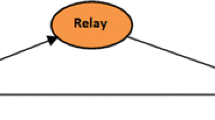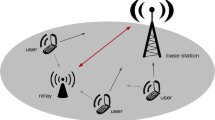Abstract
We investigate the two-hop multiple source-destination relay channels using the rate splitting transmission scheme where each source can split its message into private and public parts. We determine the system error probability via integrated exponent function under amplify-and-forward (AF) and decode-and-forward (DF) relay strategies. The most significant difference between AF and DF system error probability evaluations lies in a minimized cut-set bound of transmission rate under the DF strategy. There are many cases among transmission rate intervals for different system parameters (e.g. transmit power) and it is extremely complex to derive the system error probability for the DF strategy. We obtain a relatively simple result, which unifies various cases by a few expressions. Numerical results show that the system error probability decreases with the increase of the public message. Moreover, in order to draw deep insight into the reliability requirement of each source node in this network, we provide the error exponent region (EER) for different source nodes to show the trade-off of error probability among source nodes.
Similar content being viewed by others
References
Gamal A E, Young H K. Lecture notes on network information theory. http://arxiv.org/abs/1001.3404. 2010
IEEE. IEEE Standard 802.11: Wireless Local Area Networks. http://grouper.ieee.org/groups/802/11/. 2006
IEEE. IEEE Standard 802.16j/D7: Air Interface for Fixed and Mobile Broadband Wireless Access Systems, Multihop Relay Specification. 2007
3GPP. 3GPP TR36.913, V8.0.0: Requirements for further advancements for E-UTRA (LTE-Advanced), 2008
Van der Meulen E C. Three-terminal communication channels. Adv Appl Prob, 1971, 3: 120–154
Cover T M, Gamal A E. Capacity theorems for the relay channel. IEEE Trans Inf Theory, 1979, 25: 572–584
Kramer G, Gastpar M, Gupta P. Cooperative strategies and capacity theorems for relay networks. IEEE Trans Inf Theory, 2005, 51: 3037–3063
Shannon C E. Probability of error for optimal codes in a Gaussian channel. J Bell Syst Tech, 1959, 38: 611–656
Shannon C E, Gallager R G, Berlekamp E R. Lower bounds to error probability for coding on discrete memoryless channels part I. Inf Contr, 1967, 10: 65–103
Gallager R G. Information Theory and Reliable Communication. New York: Wiley, 1968
Gallager R G. A perspective on multiaccess channels. IEEE Trans Inf Theory, 1985, 31: 124–142
Korner J, Sgarro A. Universal attainable error exponents for broadcast channels with degraded message sets. IEEE Trans Inf Theory, 1980, 26: 670–679
Weng L, Pradhan S S, Anastasopoulos A. Error exponent regions for Gaussian broadcast and multiple-access channels. IEEE Trans Inf Theory, 2008, 54: 2919–2942
Etkin R, Merhav N, Ordentlich E. Error exponents of optimum decoding for the interference channel. In: Proceedings of IEEE International Symposium on Information Theory, Toronto, 2008. 1523–1527
Ngo H Q, Quek T Q S, Shin H D. Amplify-and-forward two-way relay channels: Error exponents. In: Proceedings of IEEE International Symposium on Information Theory, Seoul, 2009. 2028–2032
Zhang W Y, Mitra U. Multihopping strategies: An error-exponent comparison. In: Proceedings of IEEE International Symposium on Information Theory, Nice, 2007. 1411–1415
Han T S, Kobayashi K. A new achievable rate region for the interference channel. IEEE Trans Inf Theory, 1981, 27: 49–60
Csiszar I, Korner J. Information Theory: Coding Theorems for Discrete Memoryless Systems. Budapest: Akademiai Kiado, 1981
Sanov I N. On the probability of large deviations of random variables. Sel Trans Math Statist, 1961, 1: 213–244
Wang J Z, Milstein L B. CDMA overlay situations for microcellular mobile communications. IEEE Trans Commun, 1995, 43: 603–614
Frod L R, Fulkerson D R. Maximal flow through a network. J Canadian Math, 1956, 8: 399–404
Wang J Z, Chen J. Performance of wideband CDMA systems with complex spreading and imperfect channel estimation. IEEE J Sel Areas Commun, 2001, 19: 152–163
Ngo H Q, Quek T Q S, Shin H D. Random coding error exponent for dual-hop Nakagami-m fading channels with amplify-and-forward relaying. IEEE Commun Lett, 2009, 13: 823–825
Author information
Authors and Affiliations
Corresponding author
Rights and permissions
About this article
Cite this article
Deng, P., Liu, Y., Xie, G. et al. Error exponents for two-hop Gaussian multiple source-destination relay channels. Sci. China Inf. Sci. 55, 348–359 (2012). https://doi.org/10.1007/s11432-011-4326-4
Received:
Accepted:
Published:
Issue Date:
DOI: https://doi.org/10.1007/s11432-011-4326-4




